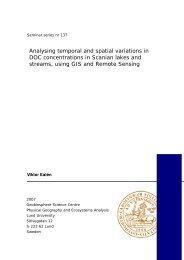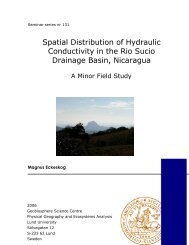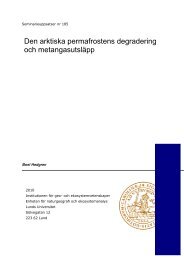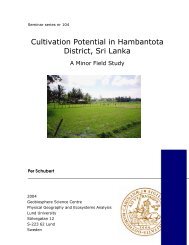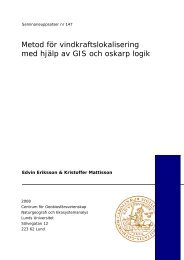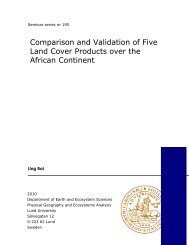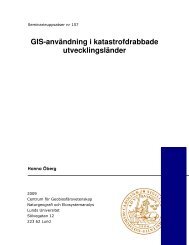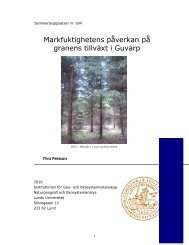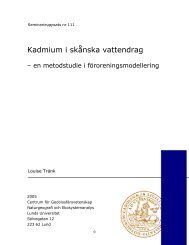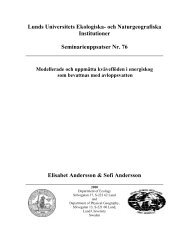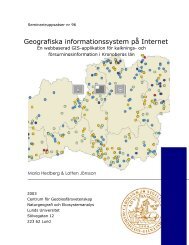Finding Potential Sites for Small-Scale Hydro Power in Uganda: a ...
Finding Potential Sites for Small-Scale Hydro Power in Uganda: a ...
Finding Potential Sites for Small-Scale Hydro Power in Uganda: a ...
You also want an ePaper? Increase the reach of your titles
YUMPU automatically turns print PDFs into web optimized ePapers that Google loves.
There are a set of tolerances used to adjust the smooth<strong>in</strong>g of <strong>in</strong>put data and theremov<strong>in</strong>g of s<strong>in</strong>ks <strong>in</strong> the dra<strong>in</strong>age en<strong>for</strong>cement process. Tolerance number one (tol1)reflects the accuracy and density of the elevation po<strong>in</strong>ts. Data po<strong>in</strong>ts, which blockdra<strong>in</strong>age by no more than this tolerance, are removed. This should be set to half of thecontour <strong>in</strong>terval when us<strong>in</strong>g contour data (Johnston et al., 2001). Tolerance number two(horizontal_std_err) represents the amount of error <strong>in</strong>herent <strong>in</strong> the process of convert<strong>in</strong>gpo<strong>in</strong>t, l<strong>in</strong>e, and polygon elevation data <strong>in</strong>to a regularly spaced grid. It is scaled by theprogram depend<strong>in</strong>g on the local slope at each data po<strong>in</strong>t and the grid cell size. Largervalues will cause more data smooth<strong>in</strong>g, result<strong>in</strong>g <strong>in</strong> a more generalized output grid.<strong>Small</strong>er values will cause less data smooth<strong>in</strong>g, result<strong>in</strong>g <strong>in</strong> a sharper output grid, which ismore likely to conta<strong>in</strong> spurious s<strong>in</strong>ks and peaks. The third tolerance (vertical_std_err)represents the amount of random error <strong>in</strong> the z-values of the <strong>in</strong>put data. The defaultvalues <strong>for</strong> horizontal and vertical standard errors are very robust and have been testedwith a wide variety of data sources. If the <strong>in</strong>terpolation results are <strong>in</strong>ferior, you shouldaccord<strong>in</strong>g to Johnston et al. (2001) check <strong>for</strong> errors <strong>in</strong> the <strong>in</strong>put data be<strong>for</strong>e chang<strong>in</strong>g thedefault values. We there<strong>for</strong>e let the tolerances be default except <strong>for</strong> the first tolerance(tol1), which we set to 15 meters, half the <strong>in</strong>put data contour <strong>in</strong>terval.4.2.3.3 S<strong>in</strong>ksA s<strong>in</strong>k is a cell or set of spatially connected cells whose neighbour<strong>in</strong>g cells all have ahigher elevation value, which means that there is no dra<strong>in</strong>age from the s<strong>in</strong>k. Naturallyoccurr<strong>in</strong>g s<strong>in</strong>ks <strong>in</strong> elevation data with a cell size of 10 meters or larger are rare except <strong>for</strong>glacial or karst areas, and generally can be considered errors. As the cell size decreases,the number of s<strong>in</strong>ks <strong>in</strong> a data set often <strong>in</strong>creases (Johnston et al., 2001). Spurious s<strong>in</strong>ksand local depressions <strong>in</strong> DEMs are a significant source of problems <strong>in</strong> hydrologicalapplications. S<strong>in</strong>ks may be caused by <strong>in</strong>correct or <strong>in</strong>sufficient data, or by an <strong>in</strong>terpolationtechnique that does not en<strong>for</strong>ce surface dra<strong>in</strong>age (Hutch<strong>in</strong>son and Dowl<strong>in</strong>g, 1991). Toelim<strong>in</strong>ate possible s<strong>in</strong>ks <strong>in</strong> the <strong>in</strong>terpolated DEM, we used the ArcGIS function “FILL”.4.2.3.4 Quality Assesment of DEMsThe quality of a derived DEM can vary greatly depend<strong>in</strong>g on the source data and the<strong>in</strong>terpolation technique. The desired quality depends on the application <strong>for</strong> which theDEM is to be used. S<strong>in</strong>ce most applications of DEMs depend on representations ofsurface shape and dra<strong>in</strong>age structure, absolute measures of elevation errors do notprovide a complete assessment of DEM quality.38



